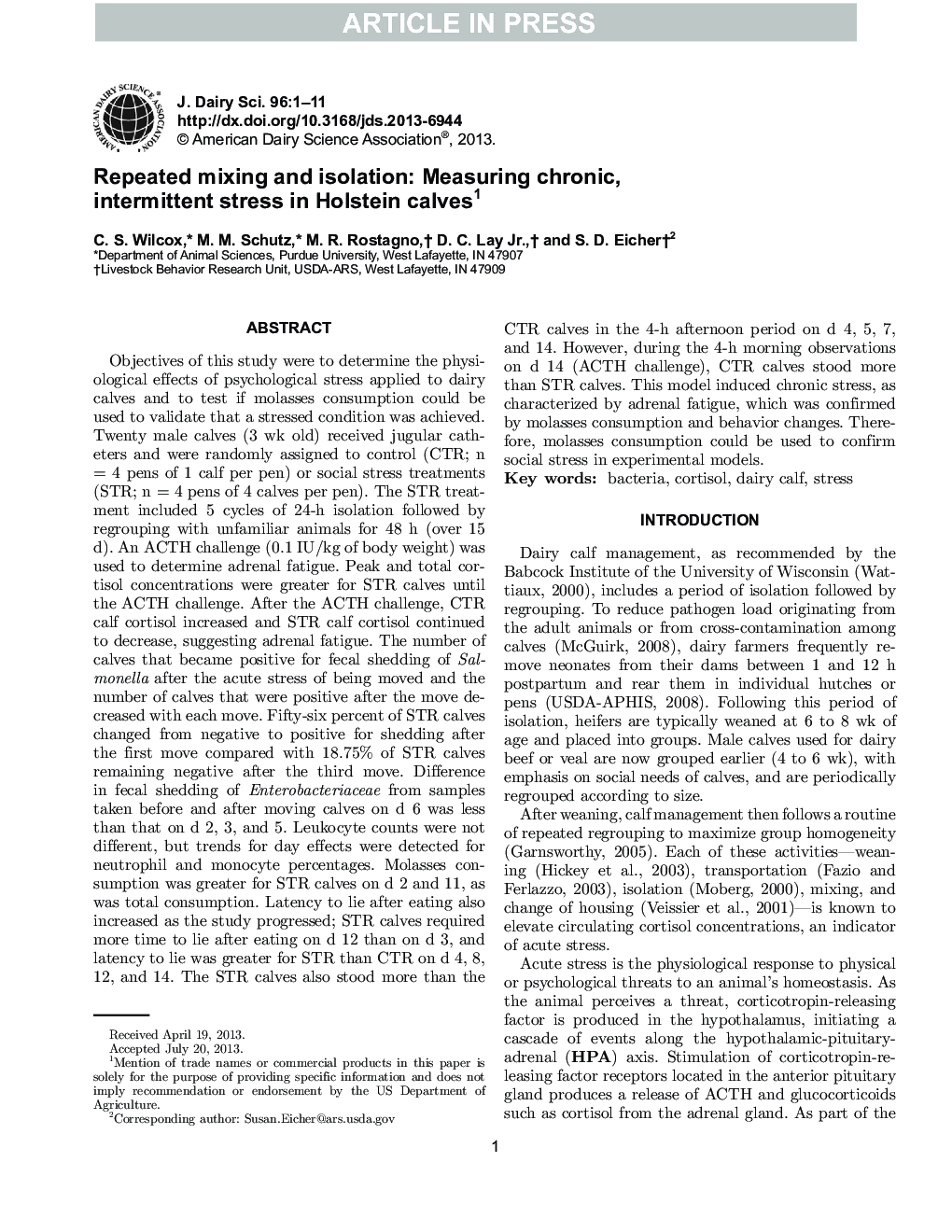| کد مقاله | کد نشریه | سال انتشار | مقاله انگلیسی | نسخه تمام متن |
|---|---|---|---|---|
| 10975057 | 1108030 | 2013 | 11 صفحه PDF | دانلود رایگان |
عنوان انگلیسی مقاله ISI
Repeated mixing and isolation: Measuring chronic, intermittent stress in Holstein calves1
ترجمه فارسی عنوان
مخلوط کردن و جداسازی مجدد: اندازه گیری تنش های مزمن و متناوب در گوساله های هلشتاین 1
دانلود مقاله + سفارش ترجمه
دانلود مقاله ISI انگلیسی
رایگان برای ایرانیان
کلمات کلیدی
باکتری ها، کورتیزول، گوساله لبنی فشار،
موضوعات مرتبط
علوم زیستی و بیوفناوری
علوم کشاورزی و بیولوژیک
علوم دامی و جانورشناسی
چکیده انگلیسی
Objectives of this study were to determine the physiological effects of psychological stress applied to dairy calves and to test if molasses consumption could be used to validate that a stressed condition was achieved. Twenty male calves (3 wk old) received jugular catheters and were randomly assigned to control (CTR; n = 4 pens of 1 calf per pen) or social stress treatments (STR; n = 4 pens of 4 calves per pen). The STR treatment included 5 cycles of 24-h isolation followed by regrouping with unfamiliar animals for 48 h (over 15 d). An ACTH challenge (0.1 IU/kg of body weight) was used to determine adrenal fatigue. Peak and total cortisol concentrations were greater for STR calves until the ACTH challenge. After the ACTH challenge, CTR calf cortisol increased and STR calf cortisol continued to decrease, suggesting adrenal fatigue. The number of calves that became positive for fecal shedding of Salmonella after the acute stress of being moved and the number of calves that were positive after the move decreased with each move. Fifty-six percent of STR calves changed from negative to positive for shedding after the first move compared with 18.75% of STR calves remaining negative after the third move. Difference in fecal shedding of Enterobacteriaceae from samples taken before and after moving calves on d 6 was less than that on d 2, 3, and 5. Leukocyte counts were not different, but trends for day effects were detected for neutrophil and monocyte percentages. Molasses consumption was greater for STR calves on d 2 and 11, as was total consumption. Latency to lie after eating also increased as the study progressed; STR calves required more time to lie after eating on d 12 than on d 3, and latency to lie was greater for STR than CTR on d 4, 8, 12, and 14. The STR calves also stood more than the CTR calves in the 4-h afternoon period on d 4, 5, 7, and 14. However, during the 4-h morning observations on d 14 (ACTH challenge), CTR calves stood more than STR calves. This model induced chronic stress, as characterized by adrenal fatigue, which was confirmed by molasses consumption and behavior changes. Therefore, molasses consumption could be used to confirm social stress in experimental models.
ناشر
Database: Elsevier - ScienceDirect (ساینس دایرکت)
Journal: Journal of Dairy Science - Volume 96, Issue 11, November 2013, Pages 7223-7233
Journal: Journal of Dairy Science - Volume 96, Issue 11, November 2013, Pages 7223-7233
نویسندگان
C.S. Wilcox, M.M. Schutz, M.R. Rostagno, D.C. Jr., S.D. Eicher,
